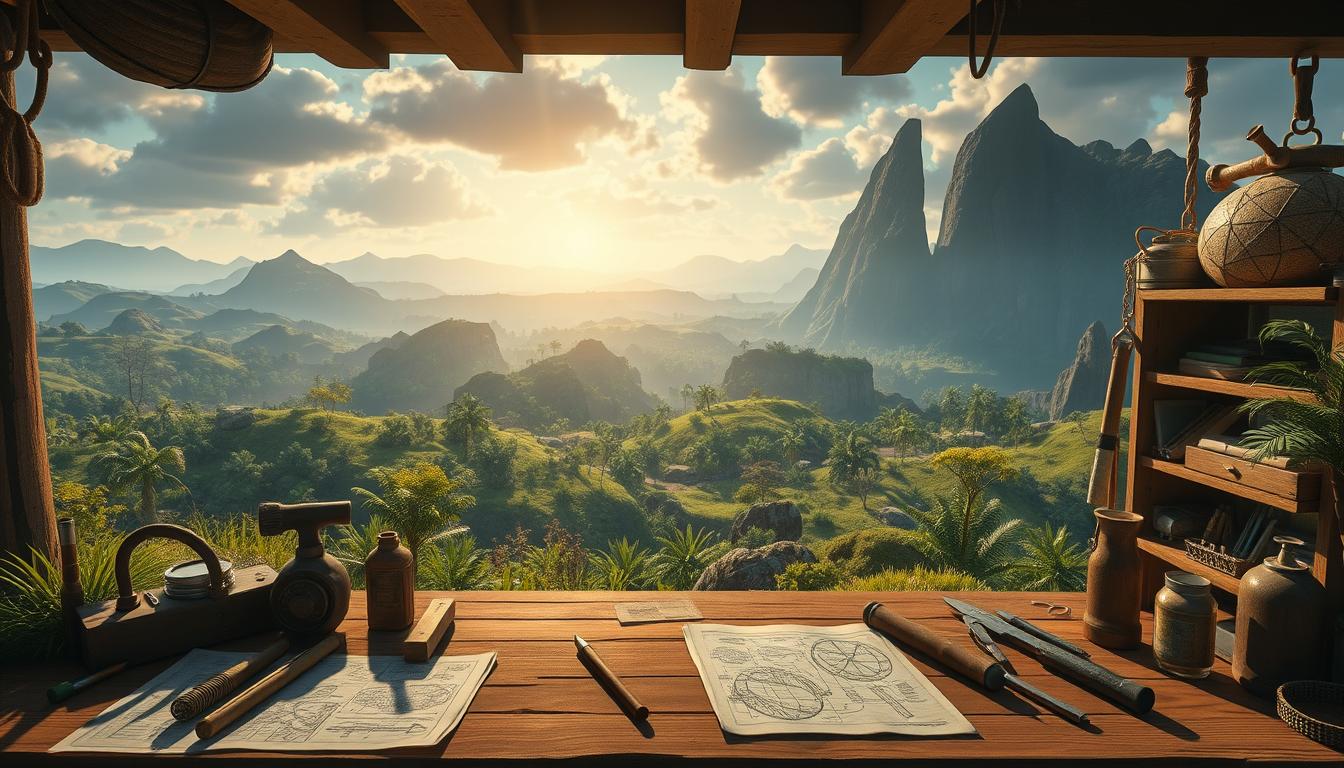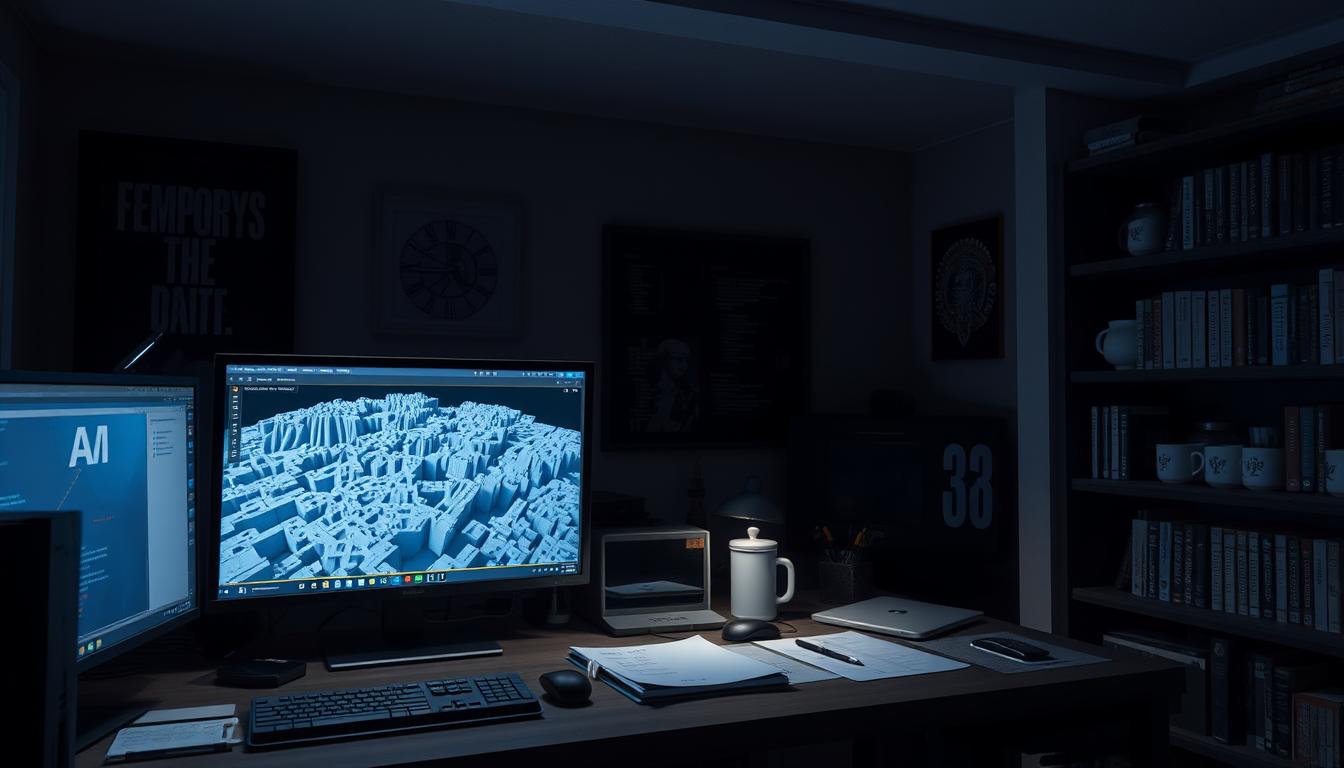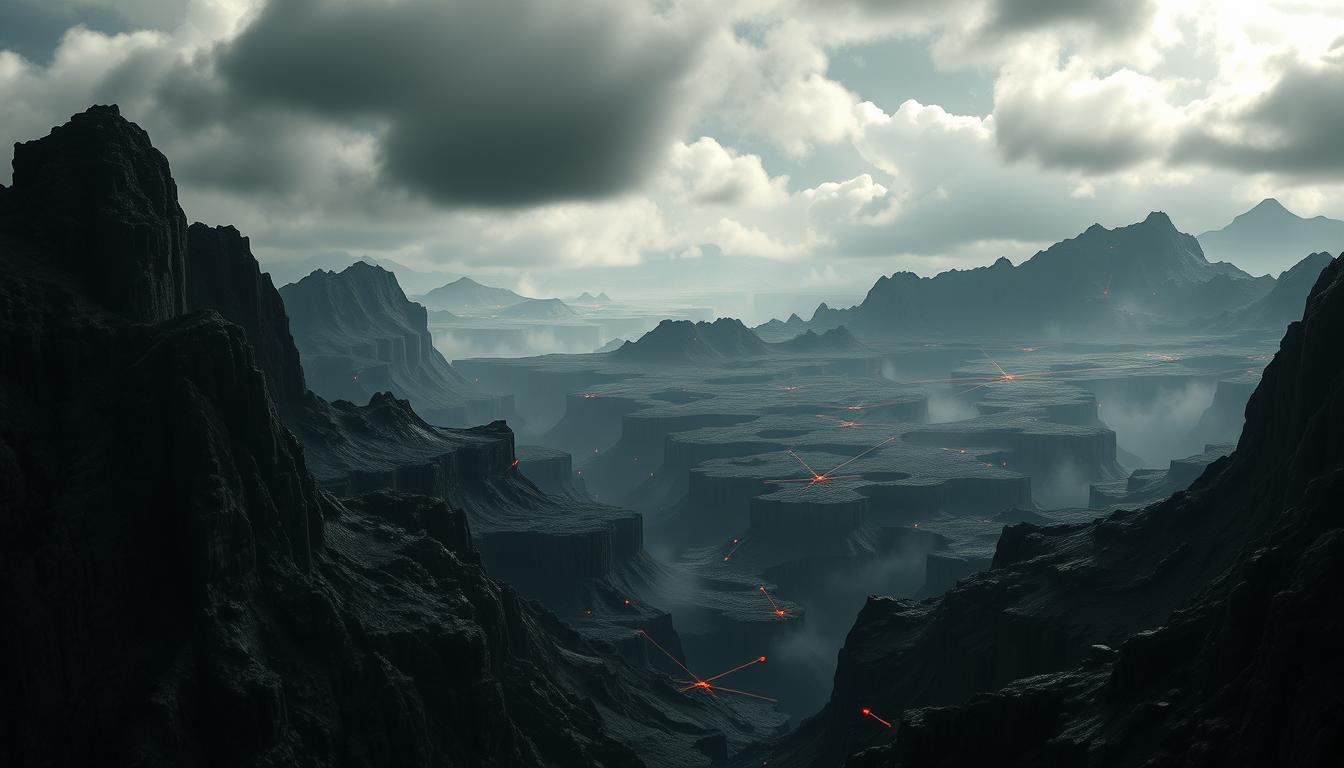Ever wondered why your Android app’s performance drops, even when it looks amazing? The problem might be overdraw, especially in maps with many interactive layers. With mobile graphics getting more complex, cutting down on overdraw is key for better app performance. This article will show you how to reduce overdraw and improve user experience in dynamic apps.
Understanding Overdraw in Mobile Graphics
Overdraw happens in Mobile Graphics when layers of graphics are stacked. This makes the device work harder, using more resources. It’s especially bad in mobile devices where resources are already tight.
When layers are stacked, it takes more memory and power to render them. This can slow down the device and use more battery. Developers need to watch out for overdraw to make apps run smoothly.
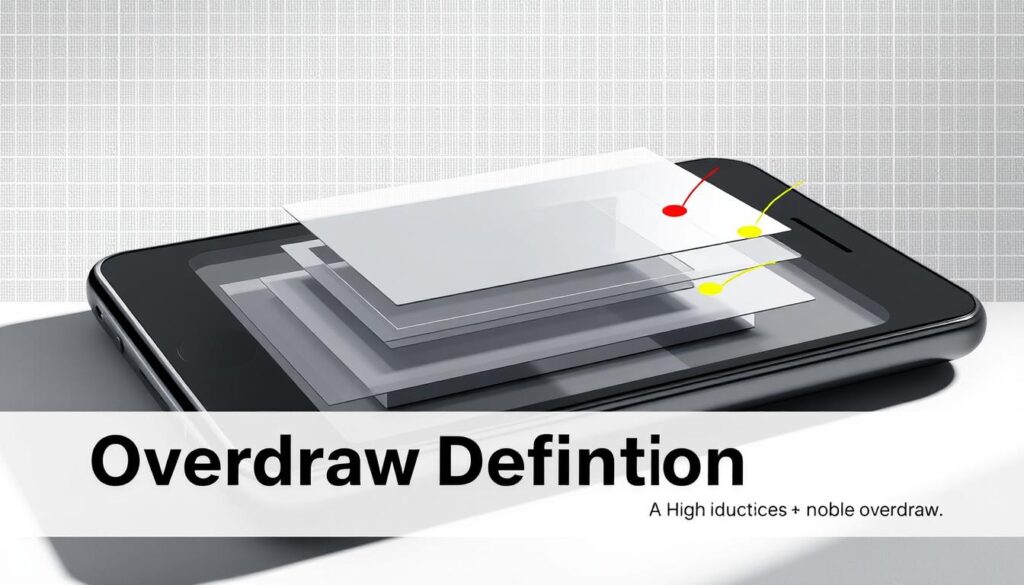
It’s important to make graphics render well on mobile devices. Knowing about overdraw helps developers improve app performance. They can make apps look good and run fast.
Impacts of Overdraw on Android Performance
Overdraw is a big problem for Android devices’ performance. When the GPU keeps drawing pixels that are already there, it hurts performance a lot. This can make apps run slower and graphics less smooth.
As developers work to improve Android, they need to know about overdraw’s effects. It can make the CPU and GPU work too hard, leading to slow animations. Also, it uses up more memory, which can make things even worse.
Knowing about these issues helps developers make better choices for their apps. By reducing overdraw, they can keep framerates high and make apps more enjoyable to use.
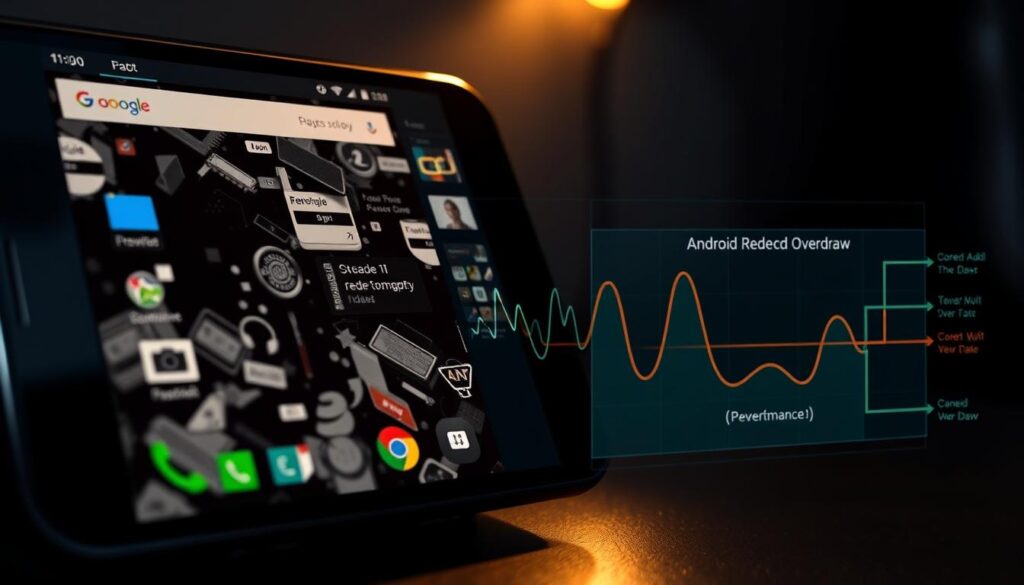
Tools for Analyzing Overdraw
Developers have many tools to analyze Overdraw, which is key for better rendering performance. Knowing how to use these tools helps find where overdraw is too much. This lets developers make specific improvements.
Using the Overdraw Scene Rendering Mode
The Overdraw Scene Rendering Mode is a great tool for seeing overdraw live. It shows which parts of the scene are drawn more than once. This helps developers find and fix unnecessary graphics layers fast.
Analyzing Performance Statistics in Game View
Looking at Performance Statistics in the game view gives more details. It shows how many draw calls, triangles, and vertices are being processed. This info helps developers find where to make things better, making the app run smoother.
| Tool | Functionality | Benefits |
|---|---|---|
| Overdraw Scene Rendering Mode | Real-time visualization of overdraw | Identifies problem areas quickly |
| Performance Statistics Analyzer | Tracks draw calls, triangles, vertices | Pinpoints optimization opportunities |
Memory Management in Layered Procedural Maps
Memory management is key to optimizing resource use in layered procedural maps. It helps developers improve performance and give users a better experience.
Optimizing Texture Usage and Compression
Texture optimization is vital for keeping memory usage low. Using special compression like ASTC or ETC2 cuts down memory use without losing quality. This frees up GPU resources and speeds up game loading, making games run smoothly on mobiles.
Reducing Texture Resolution Through Mipmaps
Mipmaps are a smart way to handle texture sizes. They use pre-made textures at different sizes, picking the right one based on distance. This saves memory and boosts performance, especially when less detail is needed.
Texture Atlases: Combining Resources
Texture atlases are key for better graphics on mobile apps. They merge many small textures into one big one. This cuts down on the number of draw calls, making things smoother.
Benefits of Using Texture Atlases
- Reduced Draw Calls: Merging textures means fewer draw calls, which boosts frame rates.
- Minimized Overdraw: With fewer textures, there’s less chance of overlap, improving performance.
- Efficient Resource Management: A tidy texture atlas makes asset management easier.
- Improved Loading Times: Using fewer, larger textures can speed up loading for users.
Tools for Creating Texture Atlases
Many tools help with texture packing, making atlas creation easier. Here are some top picks:
- Unity’s Sprite Packer: Built into Unity, it simplifies packing 2D assets, making work flow better.
- Texture Packer: A third-party tool for various game engines, great for mobile games.
- FreeTexturePacker: An open-source choice for basic texture packing needs.
Occlusion Culling: Enhancing Rendering Efficiency
Occlusion culling is key to better mobile graphics. It stops objects outside the camera’s view from being rendered. This boosts performance and makes apps run smoother on Android devices. It’s crucial for developers to grasp this concept to improve their apps.
Understanding the Basics of Occlusion Culling
Occlusion culling figures out which objects are seen and which aren’t. It’s like ignoring objects hidden by others, like buildings or terrain. This makes rendering more efficient. It lets developers create more detailed scenes without slowing down the app.
Setup Process for Occlusion Culling on Android
To set up occlusion culling on Android, follow these steps:
- Find occluder meshes, which block other objects’ views.
- Set up visibility layers to control what the camera sees.
- Adjust scene geometry to improve culling.
- Make sure the occlusion system works well with the graphics pipeline.
Overdraw Reduction in Layered Procedural Mobile Maps
It’s crucial to reduce Overdraw for better performance in mobile maps. Overdraw can make rendering smoother and improve user experience. This is especially true when different layers move together.
Managing layers is very important. By organizing layers and deciding which to show, developers can lessen the load on graphics. This not only cuts down on overdraw but also makes maps look better on mobile devices.
Developers should look at what causes overdraw. Using tools like layer visibility and efficient textures helps. This way, the engine only shows what’s needed, making rendering faster.
| Strategy | Description | Benefits |
|---|---|---|
| Layer Priority Management | Arranging layers based on visibility and importance to minimize overdraw. | Improved performance and reduced processing time for non-visible layers. |
| Efficient Texture Use | Applying compressed textures and atlases to limit texture switching and memory usage. | Decreased memory footprint and enhanced rendering speed. |
| Dynamic Layer Loading | Loading and unloading layers as needed based on user interaction. | Reductions in unnecessary data processing and enhanced responsiveness. |
By following these steps, developers can tackle overdraw and boost their mobile map apps’ quality.
Strategies for Reducing Transparent Texture Overdraw
In mobile graphics, managing transparent textures is key to better performance. These textures often cause more overdraw, which needs smart solutions. Using alpha clipping and dithering can greatly help your app’s speed.
Implementing Alpha Clipping Techniques
Alpha clipping cuts down on rendering fully transparent pixels. It uses alpha values to decide if pixels should be rendered. This method greatly reduces overdraw from transparent textures.
It ignores pixels that are too transparent, focusing only on what’s visible. This not only boosts frame rates but also lightens the GPU’s load.
Using Dithering as an Alternative
Dithering is a way to render semi-transparent areas without the full transparency cost. It blends colors to mimic different opacities. This keeps the visuals good while using fewer resources.
Dithering is a smart choice for balancing quality and efficiency. It helps manage overdraw in apps, making it a great option for developers.
| Technique | Description | Benefits |
|---|---|---|
| Alpha Clipping | Ignores fully transparent pixels during rendering | Reduces overdraw, improves performance |
| Dithering Techniques | Simulates transparency effects by blending colors | Maintains visual quality while reducing resource usage |
Optimizing Shader Usage for Mobile Applications
Shader Optimization is key for better Mobile Application performance, especially with complex graphics. Using shaders wisely can greatly improve performance. This is done by using less memory for textures while still looking great.
Utilizing Shader-Based Texture Effects
Shader-based texture effects can make visuals better without using more resources. Procedural shading creates unique textures on the fly, saving memory. This means less need for big textures, making apps faster and more flexible.
Detail Masking and Tiling Shaders for Better Performance
Detail masking and tiling shaders make things look detailed without using high-res textures. They focus on adding detail where it matters most, keeping things smooth. Tiling shaders also make small textures look big without losing quality, which is great for mobile devices. These methods help balance looks and performance.
| Technique | Description | Performance Impact |
|---|---|---|
| Shader-Based Textures | Dynamic generation of textures using shaders. | Reduces memory usage significantly. |
| Detail Masking | Applies detail only where necessary, optimizing graphics. | Minimizes overdraw, enhancing rendering speed. |
| Tiling Shaders | Utilizes small textures across larger surfaces. | Maintains quality while lowering resource demands. |
Implement Texture Streaming for Dynamic Content
Texture streaming is a smart way to use dynamic content in mobile apps. It lets developers load high-resolution textures only when they’re needed. This helps a lot in cutting down overdraw.
It keeps apps running smoothly, even when different layers are involved.
Benefits of Texture Streaming in Reducing Overdraw
Texture streaming greatly improves how apps handle overdraw. It’s great because it saves memory. Textures are only loaded when they’re needed, which is good for the graphics processing unit.
As users interact with apps, only the right textures are shown. This makes apps load faster and run smoother.
Also, texture streaming helps make apps look good without slowing them down. It’s key for keeping users interested, especially in interactive parts. Using texture streaming well can really help apps that need to show a lot of different things.
| Feature | Traditional Loading | Texture Streaming |
|---|---|---|
| Memory Usage | High | Low |
| Loading Speed | Slow | Fast |
| Overdraw Risks | High | Reduced |
| Application Responsiveness | Inconsistent | Consistent |
Texture streaming is a good choice for making mobile apps better. It helps with dynamic content and overdraw.
Best Practices for Layer Management in Procedural Maps
Managing layers well is key to better performance in procedural maps. Organizing layers right helps with graphics and cuts down on overdraw. Following best practices makes visuals better and keeps mobile devices running smoothly.
Organizing Layers to Minimize Overdraw
Developers should order layers by how visible they are. Hidden layers should be set up to not slow down the GPU. This smart setup cuts down on overdraw, making the system work better.
Putting important things first means only what’s needed is shown. This makes the graphics smoother.
Utilizing Hidden Geometry to Reduce Rendering Load
Using hidden geometry in layer management boosts performance. Making sure unseen parts don’t get rendered cuts down on work for the GPU. This makes graphics on mobile devices run smoother.
| Layer Management Strategy | Description | Impact on Overdraw |
|---|---|---|
| Visibility-Based Organization | Arranging layers based on what is visible on-screen. | Reduces unnecessary rendering of hidden layers. |
| Hidden Geometry Implementation | Excluding non-visible objects to save processing power. | Significantly lowers GPU load and increases performance. |
| Layer Priority Setting | Defining critical layers for rendering over less important ones. | Enhances rendering efficiency and minimizes overdraw. |
Performance Testing and Iteration
Performance testing is key to making layered maps better. It helps developers find and fix slow parts. They check things like how fast the map loads and how well it works on different devices.
Testing Strategies for Optimizations
Using good testing strategies is important. Here are some ways to do it:
- Automated Performance Tests: Tools can help find problems fast.
- Load Testing: See how the map handles lots of users.
- Profiling: Look at memory and CPU use to find hidden problems.
Iterative Improvement Process for Layered Maps
Improving maps is an ongoing job. It means always testing and making things better. Here’s how it works:
- Start with tests to know where to begin.
- Make changes based on what the tests show.
- Test again to see if things got better.
- Keep going until it’s just right.
Conclusion
Addressing overdraw in layered procedural mobile maps on Android is key for better performance and user experience. This article has shown how important memory management is. It helps make apps more efficient.
Using techniques like occlusion culling and texture optimization can greatly improve app performance. These methods help developers make their apps faster and more visually appealing.
By reducing overdraw, developers can make apps that are quicker and more enjoyable to use. Tools for analyzing overdraw help make informed decisions during development. This leads to happier users and better graphics.
As mobile technology keeps growing, paying attention to these performance metrics is crucial. Developers who keep improving their methods will see ongoing growth. This will lead to new and exciting ways to engage users.
FAQ
What is overdraw in mobile graphics?
Overdraw in mobile graphics happens when graphics layers overlap. This makes things less efficient, uses more CPU/GPU, and takes up more memory. It can really slow down performance, especially in Android apps.
How does overdraw affect Android performance?
Overdraw can make apps run slower, use more power, and feel less responsive on Android devices. It’s especially bad for apps that need lots of resources.
What tools can I use to analyze overdraw in my application?
You can use the Overdraw Scene Rendering Mode to see overdraw in real time. Game view’s performance stats also help spot areas to improve.
What strategies can I use for memory management in layered procedural maps?
To manage memory better, try compressing textures, downsize them, and use mipmaps. These steps can cut down on overdraw and boost performance in complex maps.
How do texture atlases improve performance?
Texture atlases merge many small textures into one big one. This cuts down on the number of draw calls, reducing overdraw and improving app speed.
What is occlusion culling, and how can it help?
Occlusion culling stops rendering objects that aren’t seen. It makes the GPU work less, making apps run smoother and faster.
How can I reduce overdraw caused by transparent textures?
Use alpha clipping to skip processing fully transparent pixels. Dithering is another option for semi-transparent areas to save on processing costs.
What are the benefits of using shaders in mobile applications?
Using shaders smartly can render complex effects without overdraw. Procedural shading and detail masking add style while keeping memory use low, key for mobile apps.
How does texture streaming help with dynamic content?
Texture streaming loads high-res textures as needed, not all at once. This cuts down on overdraw, saves memory, and speeds up app loading times.
What are best practices for organizing layers in procedural maps?
Organize layers by visibility and manage hidden geometry well to avoid overdraw. Good layer organization reduces GPU load, leading to smoother performance and better graphics.
Why is continuous performance testing important in the optimization process?
Continuous testing helps find and fix performance issues. It ensures apps run smoothly and efficiently, leading to better overall performance.


